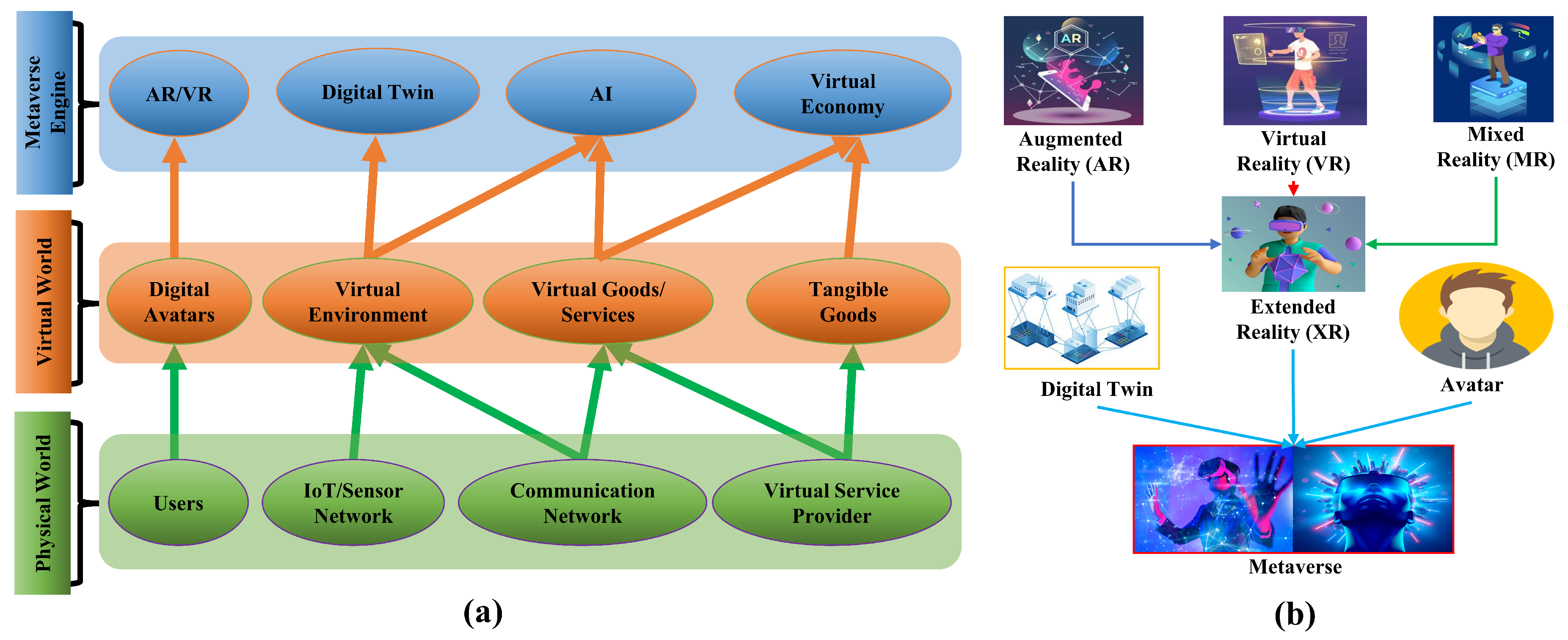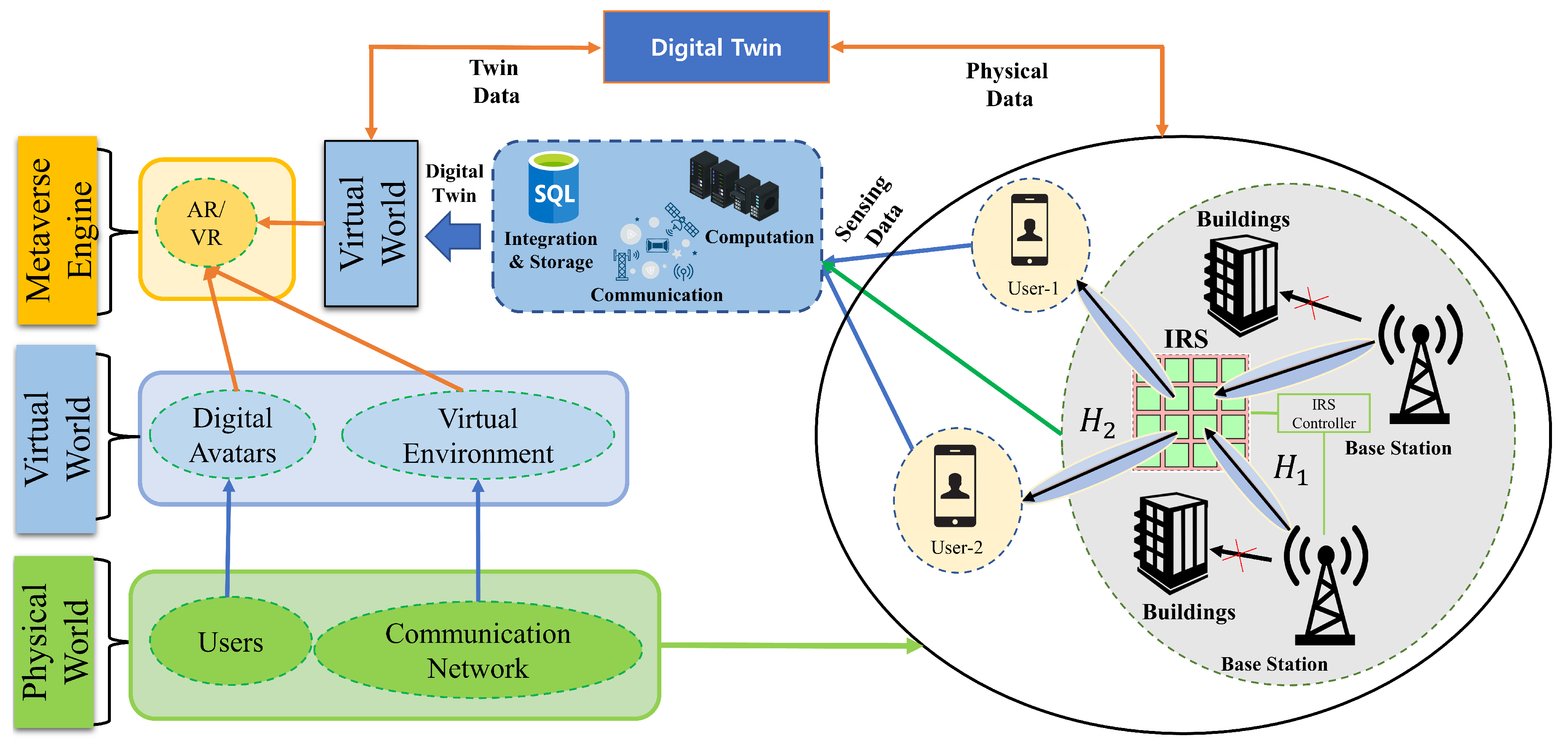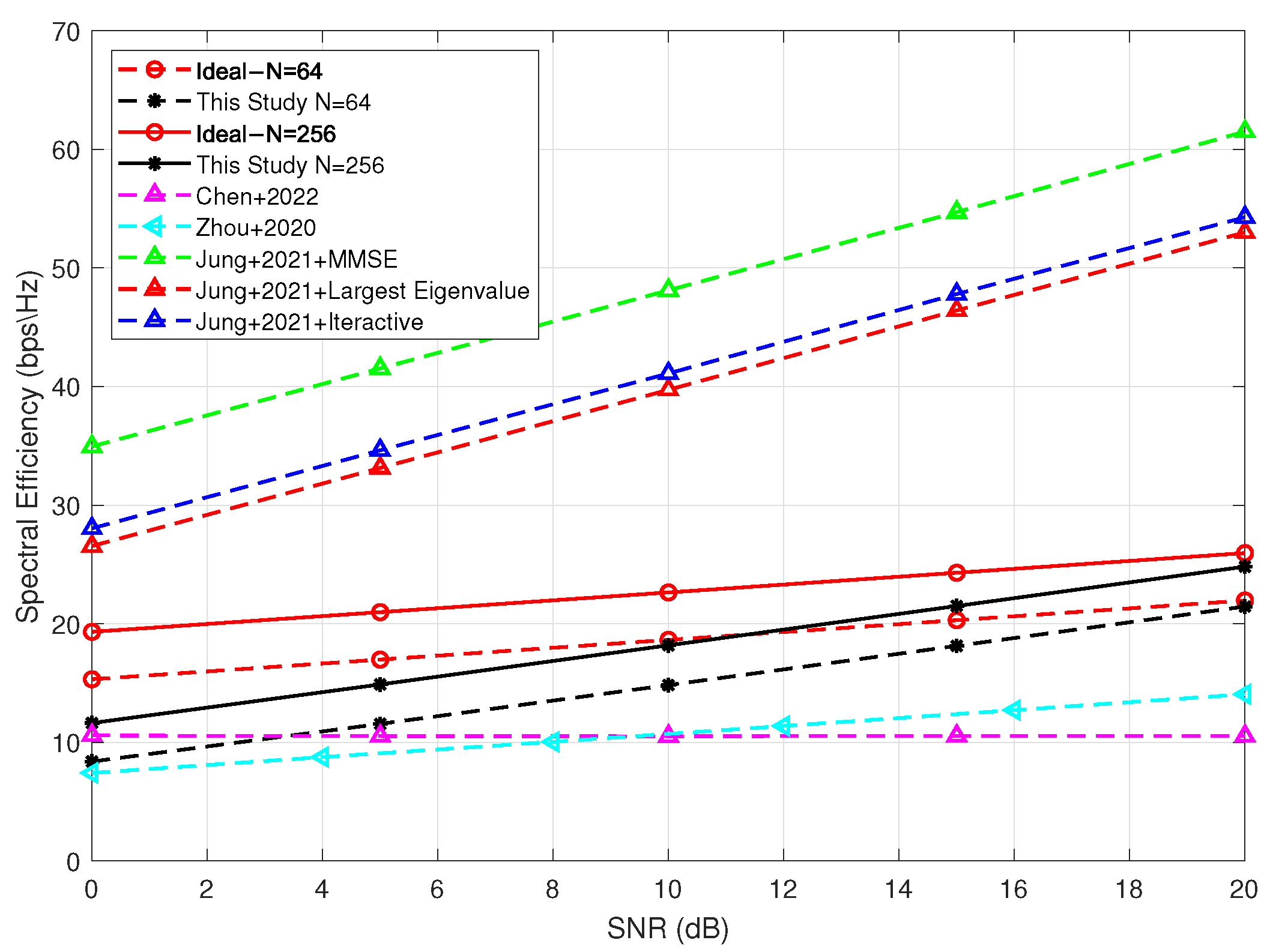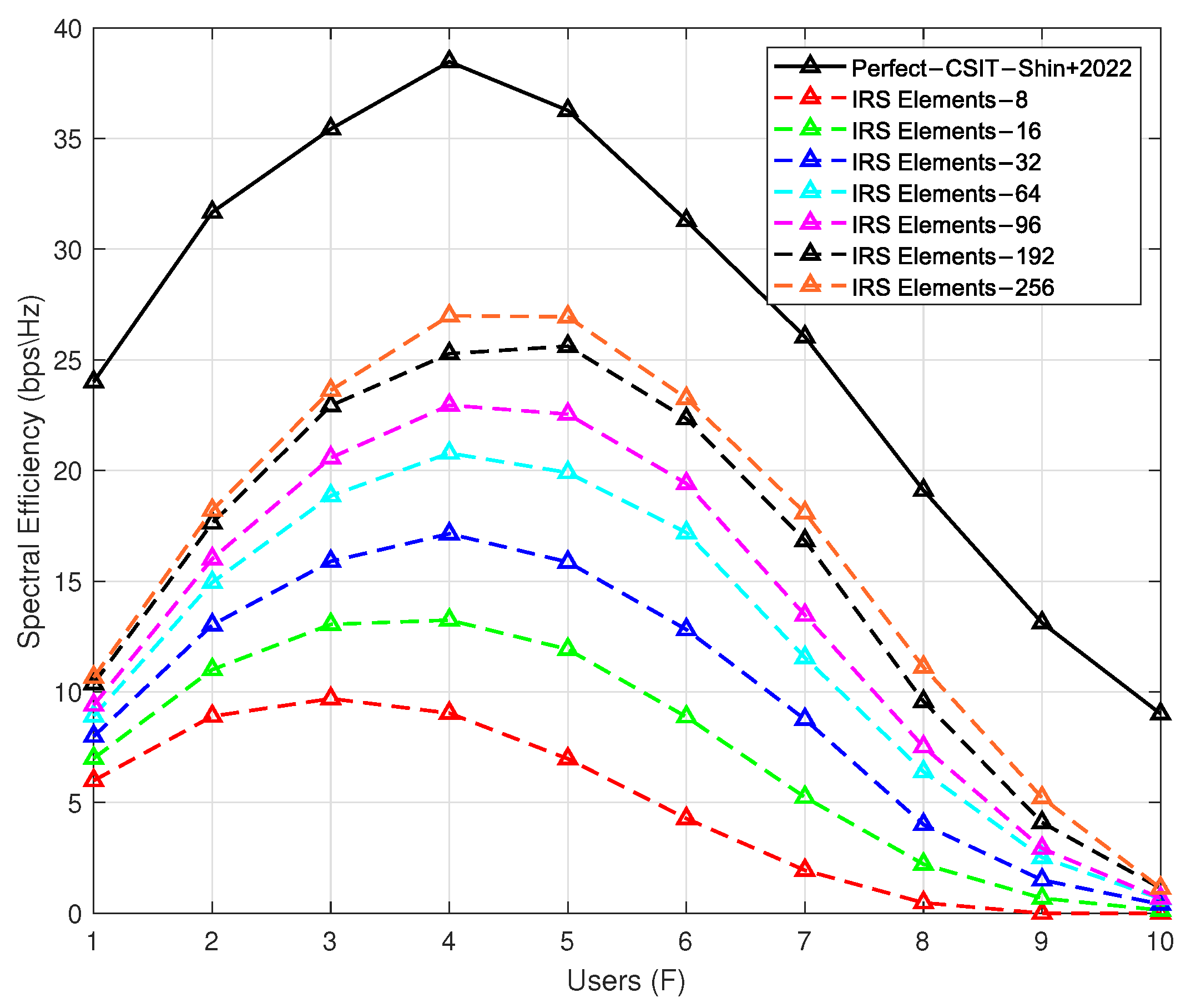Spectral Efficiency Analysis for IRS-Assisted MISO Wireless Communication: A Metaverse Scenario Proposal
Abstract
:1. Introduction
- Physical world: The physical universe offers metaverse-enabling frameworks (including sensing/control, communication, computing, and storing structures) in order to facilitate multimodal data perception, transmission, processing, and caching along with physical restraints. Effective interactions between the human and computer worlds are made possible by the physical universe. The sensing/control infrastructure is specifically made up of ubiquitous smart devices, sensors, and actuators that allow for overall, multimodal data interpretation from the circumstances and human bodies as well as very precise instrument management. The communication architecture, which is comprised of multiple heterogeneous wireless or wired communications (such as satellite communications, cellular communications, and communications from unmanned aerial vehicles), provides networking. Additionally, the computation and storage structures supported by cloud–edge-end computing make significant computation and storage capacities available [4]. For example, a virtual world must generate high-quality images for each avatar at a minimal frame rate of 30 frames per second [5], creating enormous processing requirements and delay limitations (e.g., within 1/30th of a second at most).
- Virtual world: As with ISO/IEC 23005 and IEEE 2888 regulations, the digital world can be constituted of several linked–dispersed virtual worlds (also known as sub-metaverses) [6]. Each sub-metaverse can provide users—portrayed as digital avatars—with particular ranges of virtual surroundings and services (such as gaming, social dating, online museums, and online concerts).
- Metaverse engine: Through the use of interactive AI, digital twin, and blockchain technologies, the metaverse engine [7] creates, updates, and maintains the virtual environment, utilizing extensive data from the real world as input. In particular, with the aid of XR and human–computer interactions (especially brain–computer interfaces), people situated in real environments are now able to immersively control their digital avatars in the metaverse by using their sensations and bodies for a variety of group and social activities, including vehicle racing, dating, and virtual goods trading. Because of these avatar-based digital manufacturing activities, the metaverse enables the development of the virtual economy.
- Avatar: An avatar is often thought of as a computer icon that symbolizes a player’s character in a video game. But it is much more than that. The idea of an avatar and a digital twin is comparable in the metaverse. It is a computerized representation of a person. The movements and gestures of humans are mirrored by avatars in the metaverse [8].
- Extended reality: The term “extended reality” (XR) covers VR, AR, and MR. AR allows actual items to be controlled using virtual controls, whereas VR only permits the remote control of virtual objects from the real world. AR allows for the overlay of virtual things over real-world objects. Users may smoothly engage between the virtual and real worlds due to MR, which unites them and combines VR and AR [8].
- Digital twin: The virtual or digital version of anything that exists in the actual world is called a “digital twin.” A physical object in the actual world must have the required sensors to enable its reproduction into the digital form, in that a digital twin exists.
2. Conceptual Motivation
- A novel conceptualization of metaverse scenarios with an IRS-assisted MISO system is proposed for the 6G-enabled wireless communication system. We propose the concept of physical layer communication (PHC), which provides novel connectivity in the physical world and metaverse by enhancing the desired achievable rate, bandwidth, and low latency for smooth communication paradigms. Thus, IRS-assisted wireless communication enhances the overall network performance for 6G communication expectations in metaverse scenarios.
- In PHC, the IRS-cascaded communication channel between the based station (BS) and IRS and the IRS and user equipment (UE) is considered to overcome the signal loss attributed to various obstacles, such as buildings, trees, and so on. Thus, PHC can run the digital twin of the real world and virtual world and reduce the bandwidth requirement and latency using semantic communication.
- To remove the inter-user interference (IUI), the BS employs zero-forcing (ZF) precoding with power allocation for the effective channel. Additionally, the water-filling technique [21] is employed for effective power distribution.
- Finally, the BER, SE, and throughput are observed with respect to the different modulation schemes and IRS elements. The simulation results demonstrate that these results can play a vital role in achieving the goal of 6G in the metaverse.
3. Metaverse-Enabled System Modeling
4. Communication Channel Modeling with Spectral Efficiency and Precoder Formulation
5. Simulation Results
6. Future Research Directions
- Green communication networking: For constant sensing, data transfer, and real-time communication in the metaverse, significant energy resources are needed. In order to achieve green networking, it is necessary to develop energy-efficient [28] communication protocols and use energy harvesting techniques to ensure network functioning. These topics should be researched in future works.
- Enhanced ultra-reliability and low latency system: To support VR/AR devices, metaverse services demand excellent data dependability and transmission stability in expanding high-bandwidth situations. In order to increase the transmission dependability of 6G wireless networks, IRS elements and artificial metasurfaces that may change the reflector array of incoming electromagnetic waves by autonomously manipulating the phase shift are being investigated as viable solutions. Furthermore, extremely low latency is required for critical real-time metaverse applications in order to ensure user satisfaction and avoid vertigo from the delay. To design a metaverse-enabled system, improving the latency in 6G communication is a challenging task that can be explored in future research.
- Management of heterogeneous networks: Diverse communities are brought together in the metaverse. An important area that needs to be researched is how to manage various resources and services while integrating numerous heterogeneous networks.
- Combining multiple systems: The network must incorporate several sensing, communication, and computation techniques in order to meet the stringent criteria for 6G, including Tera-Hertz (THz) communication, edge AI, energy transfer and harvesting, and communications with huge IRS elements.
- Standard specifications: Standardized network access, networking, routing, and congestion management protocols are necessary for the communication and network technologies underpinning the metaverse. While this needs a great deal of rigorous follow-up study efforts because of the heterogeneity of the unified metaverse network, these standards must be tailored to each subsystem in the metaverse.
- User experience enhancement: In a metaverse scenario, user experience is given ultimate preference to make the virtual environment real. Different wireless communication perspectives can be utilized to test the performance of metaverse environments. Parameters can be considered as channel impairment effects, channel paths, modulation techniques, data rates, and so on.
7. Conclusions
Author Contributions
Funding
Institutional Review Board Statement
Informed Consent Statement
Data Availability Statement
Conflicts of Interest
References
- Tang, F.; Chen, X.; Zhao, M.; Kato, N. The Roadmap of Communication and Networking in 6G for the Metaverse. IEEE Wirel. Commun. 2022, 1–15. [Google Scholar] [CrossRef]
- Ning, H.; Wang, H.; Lin, Y.; Wang, W.; Dhelim, S.; Farha, F.; Ding, J.; Daneshmand, M. A Survey on Metaverse: The State-of-the-art, Technologies, Applications, and Challenges. arXiv 2021, arXiv:2111.09673. [Google Scholar] [CrossRef]
- Wang, Y.; Su, Z.; Zhang, N.; Xing, R.; Liu, D.; Luan, T.H.; Shen, X. A Survey on Metaverse: Fundamentals, Security, and Privacy. IEEE Commun. Surv. Tutor. 2022. [Google Scholar] [CrossRef]
- Kai, C.; Zhou, H.; Yi, Y.; Huang, W. Collaborative cloud-edge-end task offloading in mobile-edge computing networks with limited communication capability. IEEE Trans. Cogn. Commun. Netw. 2020, 7, 624–634. [Google Scholar] [CrossRef]
- Kumar, S.; Chhugani, J.; Kim, C.; Kim, D.; Nguyen, A.; Dubey, P.; Bienia, C.; Kim, Y. Second life and the new generation of virtual worlds. Computer 2008, 41, 46–53. [Google Scholar] [CrossRef]
- Yoon, K.; Kim, S.K.; Jeong, S.P.; Choi, J.H. Interfacing Cyber and Physical Worlds: Introduction to IEEE 2888 Standards. In Proceedings of the 2021 IEEE International Conference on Intelligent Reality (ICIR), Piscataway, NJ, USA, 12–13 May 2021; pp. 49–50. [Google Scholar] [CrossRef]
- Xu, M.; Ng, W.C.; Lim, W.Y.B.; Kang, J.; Xiong, Z.; Niyato, D.; Yang, Q.; Shen, X.S.; Miao, C. A Full Dive into Realizing the Edge-enabled Metaverse: Visions, Enabling Technologies, and Challenges. IEEE Commun. Surv. Tutor. 2022. [Google Scholar] [CrossRef]
- Park, S.M.; Kim, Y.G. A Metaverse: Taxonomy, components, applications, and open challenges. IEEE Access 2022, 10, 4209–4251. [Google Scholar] [CrossRef]
- Njoku, J.N.; Nwakanma, C.I.; Kim, D.S. The Role of 5G Wireless Communication System in the Metaverse. In Proceedings of the 2022 27th Asia Pacific Conference on Communications (APCC), Jeju Island, Republic of Korea, 19–21 October 2022; pp. 290–294. [Google Scholar]
- Peng, H.; Chen, P.C.; Chen, P.H.; Yang, Y.S.; Hsia, C.C.; Wang, L.C. 6G toward Metaverse: Technologies, Applications, and Challenges. In Proceedings of the 2022 IEEE VTS Asia Pacific Wireless Communications Symposium (APWCS), Seoul, Republic of Korea, 24–26 August 2022; pp. 6–10. [Google Scholar]
- Van Huynh, D.; Khosravirad, S.R.; Masaracchia, A.; Dobre, O.A.; Duong, T.Q. Edge Intelligence-Based Ultra-Reliable and Low-Latency Communications for Digital Twin-Enabled Metaverse. IEEE Wirel. Commun. Lett. 2022, 11, 1733–1737. [Google Scholar] [CrossRef]
- Yu, J.; Alhilal, A.; Hui, P.; Tsang, D.H. 6G mobile-edge empowered metaverse: Requirements, technologies, challenges and research directions. arXiv 2022, arXiv:2211.04854. [Google Scholar]
- Jalaja, R.R.U.; Thirumavalavan, V.C.; Velmurugan, P.G.S.; Thiruvengadam, S.J. Spatially correlated dual hop RIS aided next generation wireless systems: An outage perspective. IEEE Access 2021, 9, 56127–56139. [Google Scholar] [CrossRef]
- Chaccour, C.; Soorki, M.N.; Saad, W.; Bennis, M.; Popovski, P. Risk-based optimization of virtual reality over terahertz reconfigurable intelligent surfaces. In Proceedings of the ICC 2020 IEEE International Conference on Communications (ICC), Virtual, 7–11 June 2020; pp. 1–6. [Google Scholar]
- Sejan, M.A.S.; Rahman, M.H.; Song, H.K. Demod-CNN: A Robust Deep Learning Approach for Intelligent Reflecting Surface-Assisted Multiuser MIMO Communication. Sensors 2022, 22, 5971. [Google Scholar] [CrossRef] [PubMed]
- Sejan, M.A.S.; Rahman, M.H.; Shin, B.S.; Oh, J.H.; You, Y.H.; Song, H.K. Machine Learning for Intelligent-Reflecting-Surface-Based Wireless Communication towards 6G: A Review. Sensors 2022, 22, 5405. [Google Scholar] [CrossRef] [PubMed]
- Dang, S.; Amin, O.; Shihada, B.; Alouini, M.S. What should 6G be? Nat. Electron. 2020, 3, 20–29. [Google Scholar] [CrossRef] [Green Version]
- Viswanathan, H.; Mogensen, P.E. Communications in the 6G era. IEEE Access 2020, 8, 57063–57074. [Google Scholar] [CrossRef]
- Wang, Z.; Zhao, J. Utility-Oriented Wireless Communications for 6G Networks: Semantic Information Transfer for IRS aided Vehicular Metaverse. arXiv 2023, arXiv:2305.05891. [Google Scholar]
- Rahman, M.H.; Sejan, M.A.S.; Aziz, M.A.; Baik, J.I.; Kim, D.S.; Song, H.K. Deep Learning Based Improved Cascaded Channel Estimation and Signal Detection for Reconfigurable Intelligent Surfaces-Assisted MU-MISO Systems. IEEE Trans. Green Commun. Netw. 2023. [Google Scholar] [CrossRef]
- Di, B.; Zhang, H.; Li, L.; Song, L.; Li, Y.; Han, Z. Practical Hybrid Beamforming With Finite-Resolution Phase Shifters for Reconfigurable Intelligent Surface Based Multi-User Communications. IEEE Trans. Veh. Technol. 2020, 69, 4565–4570. [Google Scholar] [CrossRef]
- Jung, J.S.; Park, C.Y.; Oh, J.H.; Song, H.K. Intelligent reflecting surface for spectral efficiency maximization in the multi-user MISO communication systems. IEEE Access 2021, 9, 134695–134702. [Google Scholar] [CrossRef]
- Wei, X.; Shen, D.; Dai, L. Channel Estimation for RIS Assisted Wireless Communications—Part II: An Improved Solution Based on Double-Structured Sparsity. IEEE Commun. Lett. 2021, 25, 1403–1407. [Google Scholar] [CrossRef]
- El Ayach, O.; Rajagopal, S.; Abu-Surra, S.; Pi, Z.; Heath, R.W. Spatially sparse precoding in millimeter wave MIMO systems. IEEE Trans. Wirel. Commun. 2014, 13, 1499–1513. [Google Scholar] [CrossRef] [Green Version]
- Chen, J.; Tan, W.; Liu, T.; Li, S.; Li, Y.; Zhou, M. Spectral efficiency for IRS-assisted uplink mmWave massive MISO systems with low-resolution ADCs. Phys. Commun. 2022, 55, 101865. [Google Scholar] [CrossRef]
- Zhou, S.; Xu, W.; Wang, K.; Di Renzo, M.; Alouini, M.S. Spectral and energy efficiency of IRS-assisted MISO communication with hardware impairments. IEEE Wirel. Commun. Lett. 2020, 9, 1366–1369. [Google Scholar] [CrossRef]
- Shin, B.S.; Oh, J.H.; You, Y.H.; Hwang, D.D.; Song, H.K. Limited Channel Feedback Scheme for Reconfigurable Intelligent Surface Assisted MU-MIMO Wireless Communication Systems. IEEE Access 2022, 10, 50288–50297. [Google Scholar] [CrossRef]
- Nain, M.; Goyal, N. Energy efficient localization through node mobility and propagation delay prediction in underwater wireless sensor network. Wirel. Pers. Commun. 2022, 122, 2667–2685. [Google Scholar] [CrossRef]








| Parameters | Value |
|---|---|
| Numbers of paths | R = 7 |
| Number of scatters | R = 15 |
| BS antenna spacing | |
| Number of UE | F = 2 |
| Number of BS antennas | M = 2 |
| Channel noise | AWGN |
| Rician factor | 15 dB |
| Modulation schemes | BPSK, QPSK, 16QAM |
| IRS elements | , |
Disclaimer/Publisher’s Note: The statements, opinions and data contained in all publications are solely those of the individual author(s) and contributor(s) and not of MDPI and/or the editor(s). MDPI and/or the editor(s) disclaim responsibility for any injury to people or property resulting from any ideas, methods, instructions or products referred to in the content. |
© 2023 by the authors. Licensee MDPI, Basel, Switzerland. This article is an open access article distributed under the terms and conditions of the Creative Commons Attribution (CC BY) license (https://creativecommons.org/licenses/by/4.0/).
Share and Cite
Rahman, M.H.; Sejan, M.A.S.; Aziz, M.A.; Kim, D.-S.; You, Y.-H.; Song, H.-K. Spectral Efficiency Analysis for IRS-Assisted MISO Wireless Communication: A Metaverse Scenario Proposal. Mathematics 2023, 11, 3181. https://doi.org/10.3390/math11143181
Rahman MH, Sejan MAS, Aziz MA, Kim D-S, You Y-H, Song H-K. Spectral Efficiency Analysis for IRS-Assisted MISO Wireless Communication: A Metaverse Scenario Proposal. Mathematics. 2023; 11(14):3181. https://doi.org/10.3390/math11143181
Chicago/Turabian StyleRahman, Md Habibur, Mohammad Abrar Shakil Sejan, Md Abdul Aziz, Dong-Sun Kim, Young-Hwan You, and Hyoung-Kyu Song. 2023. "Spectral Efficiency Analysis for IRS-Assisted MISO Wireless Communication: A Metaverse Scenario Proposal" Mathematics 11, no. 14: 3181. https://doi.org/10.3390/math11143181






